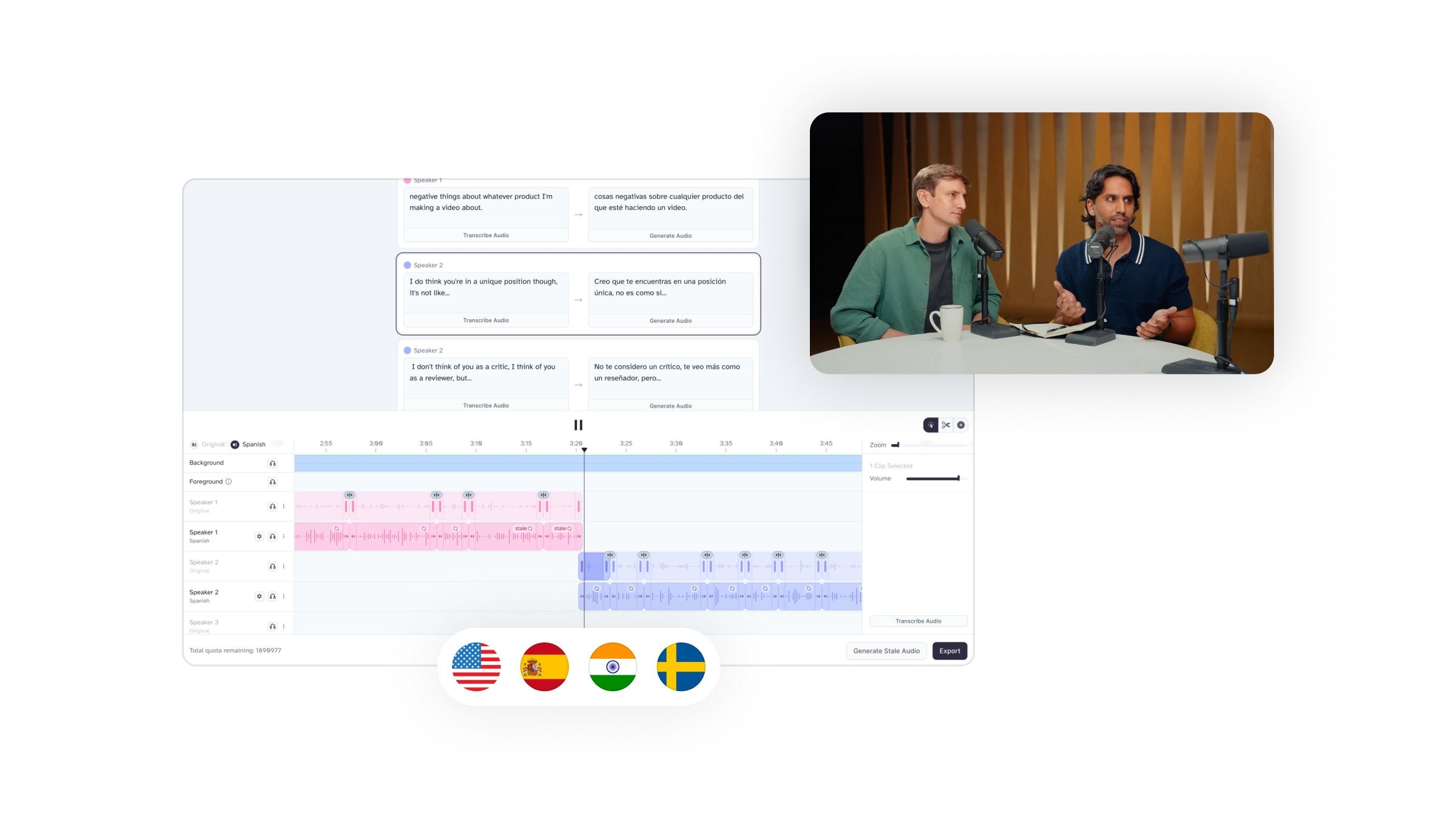
Tłumacz audio i wideo, zachowując emocje, timing, ton i unikalne cechy każdego mówcy
Dowiedz się, jak zlokalizować treści na YouTube i dotrzeć do globalnej publiczności.

Skutecznym sposobem na zwiększenie zasięgu na YouTube jest globalizacja treści poprzez tłumaczenie filmów na nowe języki.
Na przykład,MrBeast—jeden z najpopularniejszych twórców na YouTube—stworzył lokalny kanał MrBeast en Español. Wyniki? Ponad25 milionów nowych subskrybentów jego treści.
Od tego czasu połączył ten kanał z głównym kanałem za pomocą wielościeżkowego audio, co pokazuje siłę lokalizacji, gdy jest dobrze wykonana.
Proces lokalizacji to więcej niż tylko tłumaczenie. Trzeba uwzględnić niuanse kulturowe, różne prędkości internetu, napisy i inne. Na szczęście, dzięki odpowiednim strategiom lokalizacji, możesz dostosować swój kanał YouTube, aby skutecznie angażować widzów na całym świecie.
Zlokalizowane treści będą wyglądać, jakby zostały stworzone specjalnie dla zagranicznych widzów, co pomoże zwiększyć czas oglądania i subskrybentów z międzynarodowej publiczności. Chociaż lokalizacja kanału YouTube wymaga pewnego wysiłku na początku, to jeden z najlepszych sposobów na wykorzystanie globalnego zasięgu platformy.
W tym artykule przeprowadzimy cię krok po kroku przez proces lokalizacji kanału YouTube dla globalnego wzrostu.
Lokalizacja na YouTube oznacza dostosowanie kanału i jego treści do widzów z różnych regionów poprzez adaptację do ich języków i preferencji kulturowych. To więcej niż tylko tłumaczenie słów—chodzi o to, by twoje treści były istotne i zrozumiałe dla ludzi z różnych środowisk. Celem jest, aby widzowie czuli, że treści zostały stworzone właśnie dla nich, niezależnie od tego, gdzie się znajdują.
Wyjaśnimy, jak zidentyfikować swoją docelową publiczność, wybrać odpowiednie języki i przetłumaczyć treści YouTube na inne języki.
Musisz najpierw zrozumieć swoją docelową publiczność, zanim przystąpisz do lokalizacji. Kim są? Jakie mają zainteresowania? Skąd pochodzą? Rozszerzony raport analityczny YouTubedostarcza wglądu w wiek, płeć i geolokalizację twoich widzów, oferując bliższe spojrzenie na najbardziej zaangażowane segmenty publiczności.
Gdy zrozumiesz te dane demograficzne, możesz tworzyć zlokalizowane treści, które będą odpowiadać ich potrzebom i oczekiwaniom.
Wybór odpowiednich języków docelowych do lokalizacji to strategiczny krok, który może znacznie zwiększyć oglądalność twojego kanału YouTube, liczbę subskrybentów i potencjalne zyski. To wymaga zrozumienia globalnego potencjału rynku i wyboru języków, które odpowiadają szerokiej bazie widzów.
Na przykład, możesz zdecydować się na lokalizację treści na jeden z najczęściej używanych języków na świecie:
Te języki są jednymi z najczęściej używanych do dotarcia do różnorodnych odbiorców w wielu językach. Jednak nie lokalizuj treści tylko dla samego faktu. Jeśli masz więcej widzów w innych regionach, priorytetowo traktuj języki, którymi się posługują.
Pamiętaj: ostatecznym celem jest nawiązanie kontaktu z twoją publicznością w języku, który rozumieją i preferują, co buduje zaufanie i relacje.
Krótko mówiąc, aby uczynić swój kanał YouTube bardziej globalnym, zacznij od zrozumienia swoich widzów: skąd pochodzą, co lubią i jakimi językami się posługują.
Jeśli chcesz zmaksymalizować przychody generowane przez twój kanał, powinieneś również zwrócić uwagę na stawki kosztu za tysiąc wyświetleń (CPM). Innymi słowy, ile przychodów z reklam możesz wygenerować z tysiąca wyświetleń.
WedługBlogger Nexus, oto średnie stawki CPM, których możesz się spodziewać w różnych regionach.
Postępy w technologii uprościły proces pokonywania barier językowych i angażowania globalnej publiczności dla YouTuberów. Innowacyjne strategie lokalizacji, takie jak wykorzystanie technologii AI i narzędzi automatycznych, usprawniają proces tłumaczenia i poprawiają dostępność treści.
Na przykład, funkcja automatycznego tłumaczenia YouTube może szybko przetłumaczyć napisy w domyślnym języku wideo. Ale same tłumaczenia to za mało. Co jeśli chcesz opowiadać filmy w innym języku?
Funkcja wielojęzycznego audio na YouTube może znacznie zwiększyć dostępność twojego wideo i globalny zasięg. Oto jak skutecznie korzystać z tej nowo wprowadzonej funkcji.
Przykład ścieżek audio w wielu językach z jednego z filmów MrBeastfilmów
Co jeśli przesłałeś ścieżkę audio w wielu językach i chcesz ją zastąpić nową wersją? W takim przypadku postępuj zgodnie z tymi krokami:
Przejdź do „Audio” i kliknij przycisk Usuń dla odpowiedniego języka
Zauważ, że funkcja wielojęzycznego audio na YouTube nie jest jeszcze dostępna dla wszystkich użytkowników. Na przykład,MrBeastjest przykładem kanału o wysokim profilu, który korzysta z tej funkcji, aby dotrzeć do globalnej publiczności.
Jednak dla twórców, którzy nie mają dostępu do tej funkcji, istnieją alternatywne strategie do rozważenia. Na przykład,Steven & Parkerzdecydowali się uruchomić osobne kanały whiszpańskimiportugalskim, aby zaspokoić potrzeby swojej różnorodnej bazy widzów. Ta metoda pozwala twórcom poszerzyć zasięg i angażować międzynarodową publiczność, nawet bez bezpośredniego dostępu do funkcji wielojęzycznego audio.
Ważne jest, aby być świadomym, że ta funkcja YouTube nie generuje automatycznie zdubbingowanych ścieżek audio—twórcy muszą nagrać zdubbingowane ścieżki audio przed przesłaniem. Na przykład, korzystając znarzędzia do dubbingu ElevenLabs.
Dubbing ElevenLabspozwala twórcom niemal natychmiast lokalizować wysokiej jakości treści głosowe w 29 językach. Jest to szybsze, łatwiejsze i tańsze niż zatrudnianie aktora głosowego. To przyszłość lokalizacji.
Zacznij już dziś znarzędziem do dubbingu ElevenLabs.

Tłumacz audio i wideo, zachowując emocje, timing, ton i unikalne cechy każdego mówcy
Dostosowanie treści do różnych rynków może wymagać więcej niż tłumaczenia. Weź pod uwagę niuanse kulturowe, lokalne trendy i regionalny humor. Celem jest, aby każde wideo wyglądało, jakby zostało stworzone specjalnie dla tej publiczności. Może to oznaczać zmienianie lub tworzenie treści na podstawie lokalnych zainteresowań lub wydarzeń.
YouTube oferuje kilka funkcji wspierających lokalizację. Wykorzystaj te narzędzia na swoją korzyść:
Możesz się zastanawiać, czy lepiej zachować jeden kanał YouTube z treściami w wielu językach, czy założyć osobne kanały dla różnych języków. Oba podejścia mają swoje zalety i wady.
Tworzenie spersonalizowanych reklam zwiększy wskaźniki konwersji, pogłębi relacje z klientami, poprawi lojalność wobec marki i przyniesie wyższy zwrot z inwestycji w działania reklamowe.
Te reklamy są bardziej skalowalne niż bezpośrednie targetowanie wideo jeden do jednego, ponieważ pozwalają edytować istniejące treści, aby pasowały do różnych odbiorców w określonym języku. Możesz także używać ustawień geolokalizacji, aby wyświetlać spersonalizowane reklamy w zależności od miejsca, w którym znajdują się widzowie. To zapewni, że twoje filmy pojawią się w wynikach wyszukiwania i rekomendacjach dla widzów w tych lokalizacjach, w zależności od twoich ustawień.
Ponadto, możesz używaćfunkcji końcowych ekranówYouTube, aby promować filmy i dostosowywać rekomendacje do międzynarodowych widzów na podstawie ich zainteresowań kulturowych.
Tworzenie tych reklam zwiększa spersonalizowane doświadczenie dla międzynarodowej publiczności na YouTube. Wyświetlanie reklam, które są istotne dla zainteresowań widza, zwiększa prawdopodobieństwo zaangażowania i konwersji. To pozwala twojej publiczności łatwo znaleźć i konsumować treści, które odpowiadają ich zainteresowaniom i kontekstowi kulturowemu, jednocześnie pomagając ci śledzić przerwy i chronić wydajność twojej platformy.
Interakcja z lokalnymi społecznościami to potężna metoda na zwiększenie widoczności i zainteresowania publiczności. Może to obejmować:
Zaangażowanie można również zwiększyć, organizując sesje Q&A i lokalne spotkania, co daje możliwość bezpośredniej, skoncentrowanej na społeczności interakcji. Pamiętaj, że budowanie różnorodnej i przyjaznej społeczności online wymaga aktywnego moderowania komentarzy, aby promować inkluzywność i upewnić się, że międzynarodowa publiczność czuje się uwzględniona.
Lokalizacja obejmuje również dostosowanie doświadczenia użytkownika na twoim kanale YouTube. Można to osiągnąć poprzez:
Lokalizacja twojego kanału YouTube jest kluczowa z kilku powodów:
Lokalizacja to ciągły proces, który wymaga regularnego monitorowania i poprawek. Korzystając z YouTube Analytics, możesz śledzić kluczowe wskaźniki wydajności, takie jak:
Te metryki dostarczają wglądu w interakcję użytkowników z zlokalizowanymi filmami i pomagają mierzyć zasięg treści, zaangażowanie i statystyki strony.
Raporty wzrostu subskrybentów i ponowne oglądania dostarczają danych ilościowych na temat wzrostu i zainteresowań publiczności, sygnalizując skuteczność zlokalizowanych treści. Dzięki zaawansowanemu trybowi YouTube Analytics możesz tworzyć niestandardowe wykresy i porównania oraz eksportować analizy do kompleksowej oceny swoich strategii lokalizacji. Ta analiza danych pomaga zidentyfikować, co działa, co nie, i gdzie można wprowadzić ulepszenia.
Lokalizacja twojego kanału to potężna strategia, aby odblokować globalny potencjał, zwiększyć zaangażowanie widzów i zaspokoić różnorodną globalną publiczność. Od zrozumienia swojej docelowej publiczności i wyboru odpowiedniego języka docelowego po przyjęcie innowacyjnych strategii lokalizacji i wykorzystanie zaawansowanych funkcji YouTube, każdy krok odgrywa kluczową rolę w podróży lokalizacyjnej.
Gotowy, aby zacząć lokalizować swoje treści? Zacznij z narzędziem do dubbingu ElevenLabsAI Dubbing, aby bez wysiłku tłumaczyć swoje istniejące filmy.

Tłumacz audio i wideo, zachowując emocje, timing, ton i unikalne cechy każdego mówcy

Introducing a set of updates that expand what creators and developers can build with Eleven Music.

Increasing physician reach by 30% and cutting admin time by 10 hrs/week
Napędzane przez ElevenLabs Agenci